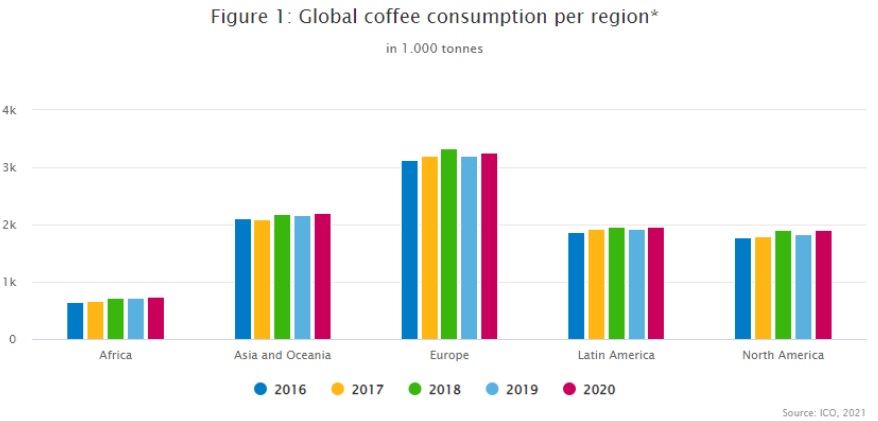Abstract
This work will allow to observe the general picture of pricing in the market, and get acquainted with the process of establishing and changing equilibrium prices for interchangeable beverages tea and coffee. The initial prices of two products – tea and coffee, as well as their sales and demand volumes will be analyzed. Then the impact of a decrease in consumer incomes will be noted, which will lead to an increase in demand for both tea and decrease for coffee at the same time, and new, lower prices will be set. It will be revealed that a decrease in the price of coffee due to a decrease in demand leads to a decrease in tea costs and, consequently, to a reduction in coffee consumption.
Introduction
Interchangeable goods in economics and consumer theory refers to a product or service that consumers see as essentially the same or sufficiently similar to another product. Substitute goods, such as various beverages, play an important role in the market and are considered useful for consumers as they provide more choices for consumers and can better meet their needs. Coffee and tea are substitutes, since the demand for one product increases when the price of another increases.
Discussion
Quantity Supplied & Quantity Demanded
The quantity demanded of tea and coffee by the population reaches significant values, but the potential demand for drinks is much higher. The reason for this is a drop in effective demand. If we calculate the structure of the price of tea or coffee, it turns out that only 15-20% of its consumer pays for the drink itself, and the rest for the packaging (CBI Ministry, 2021). Observation of the tea and coffee market over the past few years shows that quantity supplied has certain annual fluctuations (Mertens, 2022). To a large extent, they depend on the strengthening of one or another form of competition at different times of the year. For example, inter-firm competition is strong throughout the year, which arises due to the presence of various brands of tea on the market, of approximately the same quality and price. A great influence is also exerted by species competition, which arises due to the presence of different types of coffee, different not only in terms of packaging volume or its appearance.
Shifts in Quantity Supplied & Quantity Demanded
As can be seen from the graph presented in Figure 1, the total volume of the coffee market has decreased by more than 50%; this is due to a significant increase in coffee prices (CBI Ministry, 2021). Since the quantity supplied and quantity demanded of coffee decreased, respectively, there was a shift of quantity supplied and quantity demanded of coffee tea in the upward direction.

Equilibrium Prices
The equilibrium price (the intersection of the demand curve and the supply curve for tea and coffee) is equal to 40 units, at this price the consumer is ready to purchase 34 units of goods, and the manufacturer is ready to provide the same amount for sale (CBI Ministry, 2021). By using the indifference curve and budget constraints, new volumes of demand for beverages were determined, but these points of short-term equilibrium.
Changes in Equilibrium Price & Equilibrium Quantity
Changes in equilibrium price and equilibrium quantity were caused by an increase in coffee prices and a decrease in purchasing power, which delayed the achievement of an equilibrium price, increasing the demand for tea.
Shifts in Demand Curve
Shifts in demand curve for coffee are caused by a decrease in the customer’s income. Since coffee is more expensive, buyers were forced to switch to its substitute product, which is tea. Since the price of one substitute product (coffee) has increased, the demand for it has decreased, and at the same time the demand for another substitute product (tea) has increased.
Issues in Supply Chain
Issues in supply chain of tea and coffee are primarily related to logistics issues. Tea and coffee producers import raw materials for their production. However, due to the political sanctions that a number of international logistics companies have imposed on transportation, transport corridors have narrowed, and delivery times have increased, and full prepayment requirements have also arisen (Mertens, 2022). The current solution to the issues in supply chain of coffee and tea issue is to potentially simplify the scheme of suppliers’ work with networks.
Conclusion
The change in consumer incomes caused an increase in the price of both drinks, because the market did not have time to react with a change in supply. Then, under the influence of various factors, the demand for coffee decreased, which led to a decrease in its price, and since both drinks are interrelated and are substitutes for goods, this led to an increase in demand for tea and an increase in its price. After the new prices have been maintained for a long time, the supply curve has also changed, this is due to the influx of investments into a profitable industry, and the outflow from a loss-making one.
References
CBI Ministry of Foreign Affairs. (2021). What is the demand for coffee on the European market? Web.
Mertens, B. (2022). Editorial: Tea trade, coffee culture. STIR. Web.
